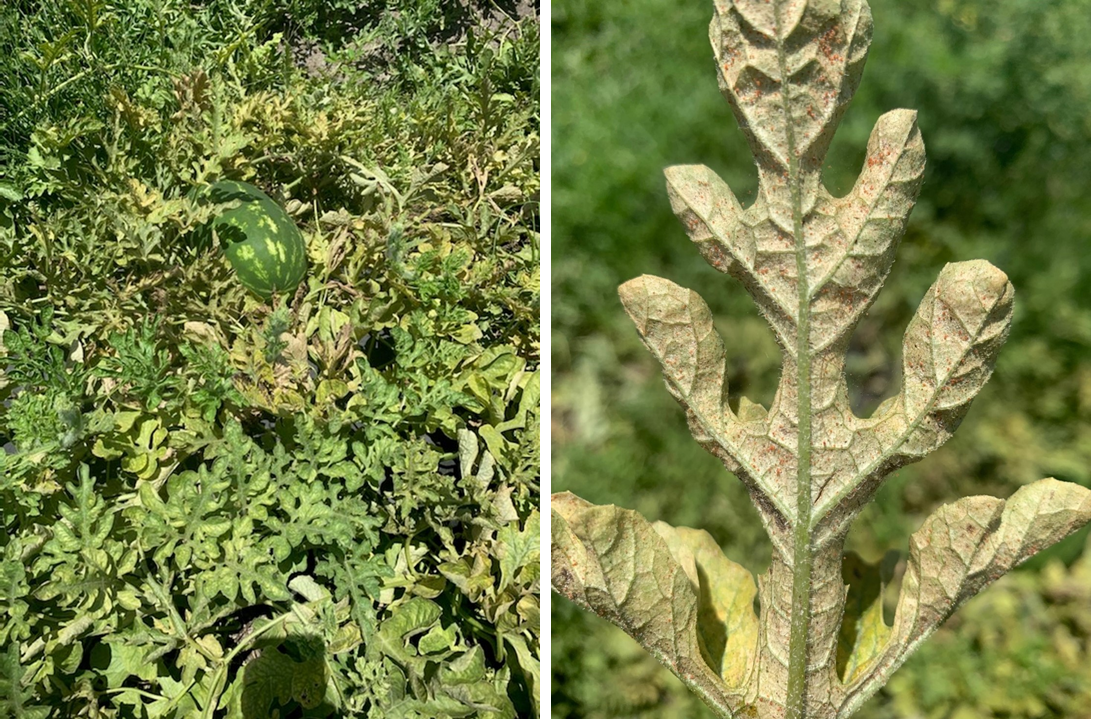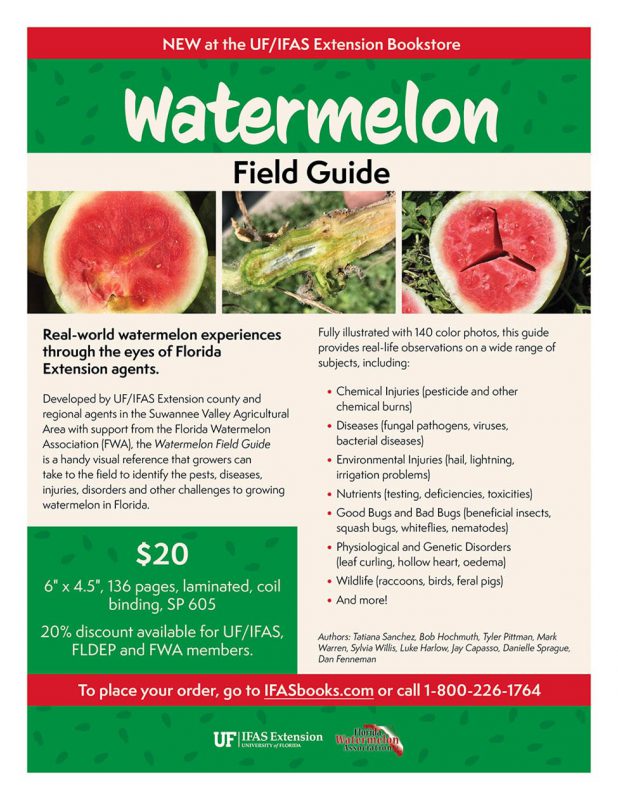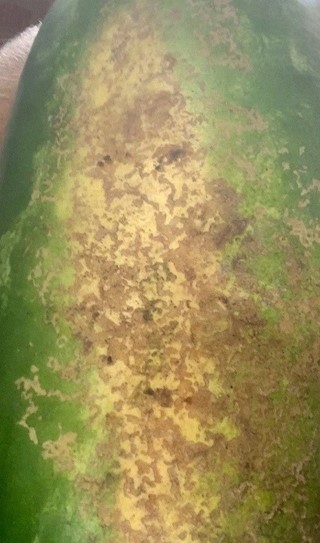UF/IFAS Extension Suwannee Valley Weekly Watermelon Crop Update. These updates are summarized by Bob Hochmuth with input from Suwannee Valley Extension Agents: Mark Warren, Tyler Pittman, Tatiana Sanchez, Luke Harlow, Jay Capasso, Sylvia Wills, Dan Fenneman, Keith Wynn, Danielle Sprague, Kevin Athearn, and Charles Barrett.
–
Disease Update
The season is winding down in many fields, but still going strong in others. Powdery mildew seems to be the disease with the greatest increase in the past week, so do not eliminate your powdery materials, if you still have a couple weeks to keep picking. At the powdery mildew fungicide trial at NFREC-SV, powdery mildew really has taken hold in a big way, so the conditions are very favorable for this disease. As noted last week, as you get to 10-14 days from final harvest, and if the field is relatively clean from disease, you should choose fungicide options wisely and consider not spraying that final week.
We are still not seeing much movement in downy mildew, which has been good news. Good fungicide programs have really helped, but we feel like there are situations where growers may be able to reduce intensity of downy mildew sprays IF, the past 2-3 weeks have included Orondis Ultra or Ranman, AND if the field looks clean from downy mildew symptoms.
Gummy stem blight is also around, but good fungicide programs there have also helped manage this disease. Please feel free to contact us with questions, but the needs are highly varied from farm to farm, so we hesitate to make any blanket recommendations (R. Hochmuth)
–
Insect Update
Rindworms are still active, so stay on a good preventative program up to that last week of harvest.
There have been scattered reports of whitefly populations that have built much earlier than anticipated. This is of concern mainly because whitefly-vectored viruses have been confirmed in these areas. The earliness of the population is what is different. We are trying to correlate the incidence with possible (likely) overwintering populations, or being brought in on transplants. If you see high populations of whitefly, let us know.
The other unusual, but isolated reports are of wireworm feeding on the bellies of watermelon fruit. The feeding looks similar to rindworm feeding, except the feeding results in smaller surface tunnels than rindworm, and wireworm feeding damage is nearly all on the belly.
We have seen several spots in fields with spider mites in the last 1-2 weeks. It has not been very widespread, but where we see these infested areas, the crop has been damaged significantly. Spider mites are not insects. They are more closely related to spiders and other arachnids. Spider mites thrive in extended periods of high temperatures and dry weather, which we had this year until just recently. The mites are very small and will be found mostly on the undersides of the leaves, scratching and sucking plant sap, and turning leaves a distinct yellow or bronze color. When broad spectrum insecticides are used beneficial insects, that help keep sider mites in check, are killed, resulting in building spider mite populations. If needed, the most effective miticides that have 3 or less days preharvest interval include Portal or Acramite. Good coverage of the undersurface of the leaves is critical so avoid mid-day spraying. Refer to pages 104-105 in your new UF/IFAS Watermelon Field Guide for more information.

Left-Spider mite damage on surrounding watermelon foliage. Right-Close up of spider mites and their damage on watermelon leaf. Credit: Bob Hochmuth, UF/IFAS
–
New Watermelon Field Guide
We are all very proud to get this “pay for” publication ready at our IFAS Extension Bookstore (see flyer below). We would not have been able to complete the printing without the sponsorship provided by the Florida Watermelon Association. We say THANK YOU to FWA for their support and collaboration on this unique field guide; the only one like it in the country! If you have any questions regarding the guide, contact your local Extension Agent.

Watermelon field guide available for $20 through IFASbooks.com
–
Reminder- Join the Florida Watermelon Association
All watermelon farmers and allied industry representatives should join. I am a member, and I encourage every reader of this weekly update to join as well. To join, go to https://www.flfwa.com/
–
Thank You to the Suwannee Valley Rapid Diagnostic Watermelon Program and Its Industry Sponsors
UF/IFAS Extension agents have initiated a more formal way to support our watermelon growers with a rapid diagnostics system through Suwannee Valley Regional. This industry-funded program allows Extension Agents to submit and pay for watermelon grower plant disease and other diagnostic samples. This SV Rapid Diagnostic Watermelon Program will help us to get quicker diagnostic results and not have to charge the growers directly. Plant disease samples are typically $40 and leaf tissue analyses are typically $20. We want to thank the initial sponsors of this program: Syngenta Crop Protection, Harrell’s Fertilizer, Koppert Biological Systems, SEEDWAY LLC, BASF Vegetable Seeds, Bayer Crop Science, Gowan Seed, and Gowan USA for sponsoring this effort. Other industry reps interested in sponsoring this effort can contact Bob Hochmuth at bobhoch@ufl.edu or 386-288-6301.
- 2024 Watermelon Season Wrap Up - June 21, 2024
- Weekly Watermelon Update – June 3 - June 7, 2024
- Weekly Watermelon Update #10 – May 20 - May 24, 2024

